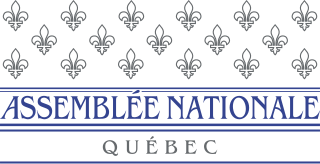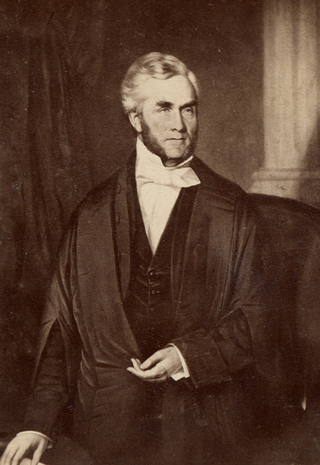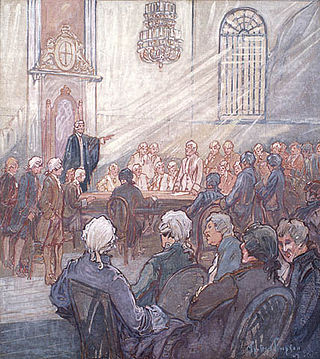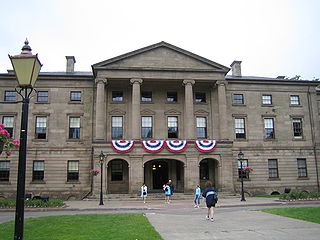
The Province of Canada was a British colony in British North America from 1841 to 1867. Its formation reflected recommendations made by John Lambton, 1st Earl of Durham, in the Report on the Affairs of British North America following the Rebellions of 1837–1838.

The National Assembly of Quebec is the legislative body of the province of Quebec in Canada. Legislators are called MNAs. The lieutenant governor of Quebec and the National Assembly compose the Legislature of Quebec, which operates in a fashion similar to those of other Westminster-style parliamentary systems. The assembly has 125 members elected first past the post from single-member districts.

The Legislative Assembly of Prince Edward Island together with the lieutenant governor of Prince Edward Island form the General Assembly of Prince Edward Island. The Legislative Assembly meets at Province House, which is at the intersection of Richmond and Great George Streets in Charlottetown. Bills passed by the Assembly are given royal assent by the lieutenant governor in the name of the King of Canada.

The Executive Council of Alberta is a body of ministers of the Crown in right of Alberta, who along with the lieutenant governor, exercises the powers of the Government of Alberta. Ministers are selected by the premier and typically sit as a member of the Legislative Assembly (MLA). It is the provincial equivalent to the federal Cabinet of Canada.

Sir Dominick Daly was a British colonial public servant and administrator during the 19th century, who held positions in British North America, Tobago and South Australia.

Augustin-Norbert Morin was a Canadien journalist, lawyer, politician, and rebel in Lower Canada. He was a member of the Legislative Assembly of Lower Canada in the 1830s, as a leading member of the Parti patriote. Although he participated in the Lower Canada Rebellion, the British authorities concluded his conduct did not warrant a charge of high treason. After the Rebellion, he entered politics in the Province of Canada, eventually becoming joint premier of the Province. Retiring from politics due to health concerns, Morin was appointed to the bench. He was one of the commissioners who codified the law of Lower Canada, producing the Civil Code of Lower Canada which stayed in force for over a century.

The Legislative Assembly of Upper Canada was the elected part of the legislature for the province of Upper Canada, functioning as the lower house in the Parliament of Upper Canada. Its legislative power was subject to veto by the appointed Lieutenant Governor, Executive Council, and Legislative Council.

The Legislative Council of Upper Canada was the upper house governing the province of Upper Canada. Modelled after the British House of Lords, it was created by the Constitutional Act of 1791. It was specified that the council should consist of at least seven members. Members were appointed for life but could be dropped for non-attendance. The first nine members of the council were appointed on 12 July 1792. The speaker was usually the Chief Justice of the Court of King's Bench. The Legislative Council was dissolved on 10 February 1841 when Upper and Lower Canada were united into the Province of Canada. Some members were reappointed to the Legislative Council of the united Province.

The First Parliament of the Province of Canada was summoned in 1841, following the union of Upper Canada and Lower Canada as the Province of Canada on February 10, 1841. The Parliament continued until dissolution in late 1844.

James Morris was a businessman, banker and political figure in Canada West. He was a member of the Legislative Assembly of the Province of Canada, as a Reformer. He was later a member of the Legislative Council, serving as the Speaker of the Legislative Council. He was also a member of the Executive Council of the province.

The Legislative Assembly of Lower Canada was the lower house of the bicameral structure of provincial government in Lower Canada until 1838. The legislative assembly was created by the Constitutional Act of 1791. The lower house consisted of elected legislative councilors who created bills to be passed up to the Legislative Council of Lower Canada, whose members were appointed by the governor general.
The Legislative Council of Lower Canada was the upper house of the Parliament of Lower Canada from 1792 until 1838. The Legislative Council consisted of appointed councillors who voted on bills passed up by the Legislative Assembly of Lower Canada. The legislative council was created by the Constitutional Act. Many of the members first called in the Council in 1792 had served as councillors in the Council for the Affairs of the Province of Quebec.
The Legislative Council of Newfoundland was the upper house of the General Assembly of Newfoundland from 1833 to 1934.

The Province of Manitoba, similar to other Canadian provinces and territories, is governed through a Westminster-based parliamentary system. The Manitoba government's authority to conduct provincial affairs is derived from the Constitution of Canada, which divides legislative powers among the federal parliament and the provincial legislatures. Manitoba operates through three branches of government: the executive, the legislative, and the judicial. The executive branch—the Government of Manitoba—consists of the Executive Council and the Premier, who is the head of government and the President of the Executive Council. The legislative branch—the Manitoba Legislature—is composed of the Lieutenant Governor and the Legislative Assembly, which is composed of the 57 members (MLAs) elected to represent the people of Manitoba, as well as the Speaker, the Clerk, the Officers of the Legislative Assembly, and the employees of the legislative service.

The First Legislature of Quebec was summoned in 1867 when the new Canadian province of Quebec was created, as part of the new country of Canada.

The General Assembly of Prince Edward Island is the unicameral legislature of the province of Prince Edward Island, Canada, consisting of the lieutenant governor and the Legislative Assembly of Prince Edward Island. The legislature was first established in 1773.
The Executive Council of the Province of Canada had a similar function to the Cabinet in England but was not responsible to the Legislative Assembly of the Province of Canada from its inception in 1841 to 1848.

The Legislative Council of Nova Scotia was the upper house of the legislature of the Canadian province of Nova Scotia. It existed from 1838 to May 31, 1928. From the establishment of responsible government in 1848, members were appointed by the lieutenant governor of Nova Scotia on the advice of the premier.

The Parliament of the Province of Canada was the legislature for the Province of Canada, made up of the two regions of Canada West and Canada East.















